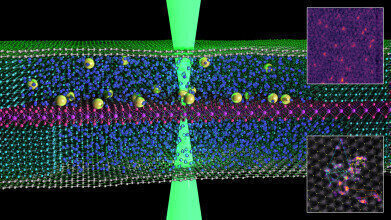-
 Fast-moving Dirac fermions exhibiting high mobility in the graphene (credit: University of Manchester)
Fast-moving Dirac fermions exhibiting high mobility in the graphene (credit: University of Manchester)
News & Views
Graphene reveals surprising Magnetoresistance Response
May 04 2023
Materials capable of changing resistivity under magnetic fields are highly sought after for use in numerous product designs that use tiny magnetic sensors. Such materials are rare and most metals and semiconductors only change electrical resistivity by a tiny fraction of a percent at room temperature in practically viable magnetic fields. Observation of magnetoresistance response is normally conducted on materials cooled to liquid-helium temperatures, so that electrons inside scatter less and can follow cyclotron trajectories.
Now researchers led by Professor Sir Andre Geim at the University of Manchester have been surprised to discover that graphene exhibits a remarkably strong response, reaching above 100% in magnetic fields of standard permanent magnets (of about 1,000 Gauss). This is a record magnetoresistivity among all the known materials.
“People working on graphene like myself always felt that this gold mine of physics should have been exhausted long ago,” said Professor Geim The material continuously proves us wrong finding yet another incarnation. Today I have to admit again that graphene is dead, long live graphene.”
The researchers tuned high quality graphene to its intrinsic, virgin state where there were only charge carriers excited by temperature. This created a plasma of fast-moving “Dirac fermions” that exhibited high mobility despite frequent scattering. Both high mobility and neutrality of this Dirac plasma are crucial components for the reported giant magnetoresistance.
“Over the last 10 years, electronic quality of graphene devices has improved dramatically, and everyone seems to focus on finding new phenomena at low, liquid-helium temperatures, ignoring what happens under ambient conditions. This is perhaps not so surprising because the cooler your sample the more interesting its behaviour usually becomes. We decided to turn the heat up and unexpectedly a whole wealth of unexpected phenomena turned up”, said Dr Alexey Berdyugin, one of the corresponding authors of the paper.
In addition to the record magnetoresistivity, the researchers also found that, at elevated temperatures, neutral graphene becomes a so-called “strange metal”, describing materials where electron scattering becomes ultimately fast, being determined only by the Heisenberg uncertainty principle. The behaviour of strange metals is poorly understood and remains a mystery currently under investigation worldwide.
The Manchester work added more mystery by showing that graphene also exhibits a giant linear magnetoresistance in fields above a few Tesla, which is weakly temperature dependent. This high-field magnetoresistance is again record-breaking.
“Undoped high-quality graphene at room temperature offers an opportunity to explore an entirely new regime that in principle could be discovered even a decade ago but somehow was overlooked by everyone. We plan to study this strange-metal regime and, surely, more of interesting results, phenomena and applications will follow”, added Dr Leonid Ponomarenko, one of the leading Nature paper authors.
Published in Nature: Giant magnetoresistance of Dirac plasma in high-mobility graphene:12.04.23 DOI 10.1038/s41586-023-05807-0
More information online
Digital Edition
ILM 49.5 July
July 2024
Chromatography Articles - Understanding PFAS: Analysis and Implications Mass Spectrometry & Spectroscopy Articles - MS detection of Alzheimer’s blood-based biomarkers LIMS - Essent...
View all digital editions
Events
Jul 28 2024 San Diego, CA USA
Jul 30 2024 Jakarta, Indonesia
Jul 31 2024 Chengdu, China
ACS National Meeting - Fall 2024
Aug 18 2024 Denver, CO, USA
Aug 25 2024 Copenhagen, Denmark

.jpg)

24_06.jpg)













